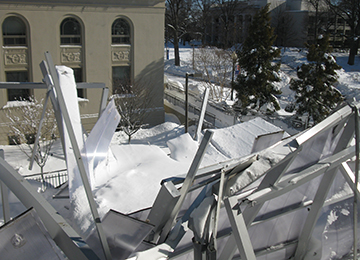There was a lot of discussion about the economic losses due to the recent snowstorm in the Washington, D.C. region. While the Capitol area was hit hard due to lost productivity, lost wages, and cash registers not ringing in stores and restaurants, the area was still very fortunate.
One item that didn’t make the news, primarily because it didn’t occur with much frequency, was roofs collapsing. If the weight of snow on a rooftop exceeds the roof load capacity, it’s possible that the roof structure can be damaged or experience partial or complete collapse. Contacting a structural engineer to review your building’s roof structure can be wise before the next big snowstorm hits.
The actual unit weight of snow varies depending on the moisture content (i.e. how “dense” or “heavy” the snow is). That hinges on a variety of atmospheric conditions, including humidity, temperature, rainfall, and wind.
If the weight of the accumulated snow is greater than the roof’s load capacity, one of the only solutions is to clear the snow from the roof. This process requires care and should be undertaken by experienced personnel. Metal shovels or other tools with sharp edges may damage roof membranes and compromise the roof’s ability to keep water out of the structure. Snow should be removed around vents and vent pipes, intake fans, and air ducts. Snow and ice should also be removed from gutters and drains whenever possible.
Structures with flat roofs, well-insulated roofs, and unheated structures, such as garages, barns, and sheds, are at particular risk for heavy snow loads. Rising heat from a home or business can help snow melt, allowing water to run down a pitched roof. While that reduces the snow load, snow melt can cause ice dams that form near the edge of the roof where the water refreezes. An ice dam can allow additional water trying to drain off the roof to “back-up” and overwhelm a shingled or metal roof’s ability to keep water out of the structure. Ice dams can also damage even a well-designed and installed roof, so removal of excess ice from roof edges is recommended.

